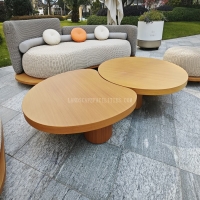Welcome to the website for landscape facilities products and knowledge.
How does the table’s design handle exposure to high levels of coastal wind?
Coastal environments present unique challenges for outdoor furniture, particularly when it comes to withstanding persistent and powerful winds. Modern table designs address these challenges through multiple engineering approaches that ensure stability and longevity in windy conditions.
The foundation of wind-resistant table design begins with strategic weight distribution. Manufacturers often incorporate heavier materials in the base structure or add integrated anchoring systems that can be secured to decks or patios. This low center of gravity prevents tipping even during sudden wind gusts that can reach considerable velocities in coastal areas.
Material selection plays a crucial role in wind resistance. Powder-coated aluminum has become a preferred choice for coastal applications due to its optimal balance of weight and strength. Unlike solid wood that can act as a sail in high winds, aluminum frames often feature perforated or slatted designs that allow wind to pass through rather than accumulate pressure against solid surfaces.
Advanced engineering includes aerodynamic profiles that minimize wind resistance. Table designers create streamlined shapes and incorporate ventilation channels within the table structure. These features disrupt wind flow patterns, reducing the lifting force that can potentially overturn furniture during storm conditions. Some premium designs even include built-in wind baffles that redirect air currents away from the table surface.
The integration point between table tops and bases receives special attention in coastal designs. Most wind-resistant tables feature reinforced connection systems using marine-grade stainless steel fasteners that resist corrosion while providing superior holding power. Many designs incorporate a dual-locking mechanism that secures the table top from both vertical lift and horizontal shift.
For ultimate protection, several manufacturers offer optional ground anchoring systems specifically designed for coastal applications. These systems typically involve screw-in earth anchors or weighted base plates that can be permanently installed while remaining discreetly hidden beneath the table structure. Such solutions are particularly valuable in locations experiencing frequent high-wind warnings.
Regular maintenance enhances a table's ability to withstand coastal winds. Checking and tightening connection points seasonally, ensuring drainage channels remain clear, and verifying that any anchoring systems remain secure all contribute to maintaining optimal wind resistance throughout the furniture's lifespan. Proper care ensures that the engineering features continue to perform as designed even after years of exposure to challenging coastal conditions.
Related search:

Recommendation
Elliptical metal outdoor table with nested design, resembling wood grain, round table